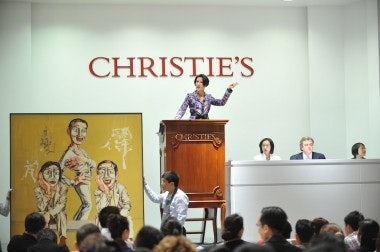What Does It Mean For China?#

A work by Zeng Fanzhi is auctioned off at Christie's, Hong Kong
According to an article this week in the Art Newspaper, a study by the non-profit dealer's federation, Cinoa (Confédération Internationale des Négociants en Oeuvres d’Art) found that fair-led, auction business and online media are replacing the traditional gallery model as the main source of revenue in the global art world.
While many galleries continue to make profits, the study claims, most of this comes from sales at art fairs. As András Szántó, consultant and contributing editor to The Art Newspaper, commented, “The fairs have done very well in exploiting a structural weakness of the gallery system—it is inchoate and based on local markets.” Particularly in the economic downturn, art fairs or online media are more effective in terms of better serving local clients who are not able to visit galleries frequently.
In addition to art fairs and online media, many artists today work directly with the auction houses to place their works. Shortly before the onset of the global economic crisis, British artist Damien Hirst circumvented the galleries with which he had a long-standing relationship and successfully brought in over US$200 million selling his complete show, Beautiful Inside My Head Forever.
The Art Newspaper article also makes mention of an interesting phenomenon, that the growth of art fairs has been spurred on by the growth of non-Western markets, particularly those in the Asia-Pacific region. For instance, Art HK (as of May now 60 percent owned by Art Basel) has, in recent years, been recognized as a leading art fair not only in Asia but globally as well. As Jing Daily wrote in our coverage of the event earlier this year, with 260 galleries from 38 countries showcasing the largest display of contemporary art ever seen in Hong Kong, Art HK11 attracted much attention from international dealers and new Asian collectors.
The expansion of the auction business and art fairs is adding a whole layer above the gallery system as it evolved in the 20th century, said András Szántó. In Jing Daily's opinion, this major systemic shift also reinforces the state of the gallery system in China, where that system is weak. According to a recent article from China Culture Daily, as of this May, there were a total of 1,512 regular galleries in China's major cities, including 605 in Beijing, which accounts for 40 percent, and 273 in Shanghai, accounting for 16 percent. However, most of China's galleries are still operating within the traditional system, which is the lowest trading model in the art market, said Dong Mengyang, executive director and curator of Art Beijing.
With the traditional gallery system in China shifting, new models are being tested in China. Blue-chip contemporary artists, including Cai Guoqiang, Zeng Fanzhi and Yue Minjun, have now chosen to work more closely with both private and public museums and more directly with curators and large collectors like François Pinault.
Jing Daily noted some artists prefer direct relationships and, essentially, patronage. In China, the gallery system lacks the long history and heritage of that seen in Western countries, and while the gallery system in China is still in its infancy -- dating back only a few decades -- China's most high-profile artists have found a successful way to jump ahead in the art world: working directly with museums, biennials, global collectors, and auction houses.